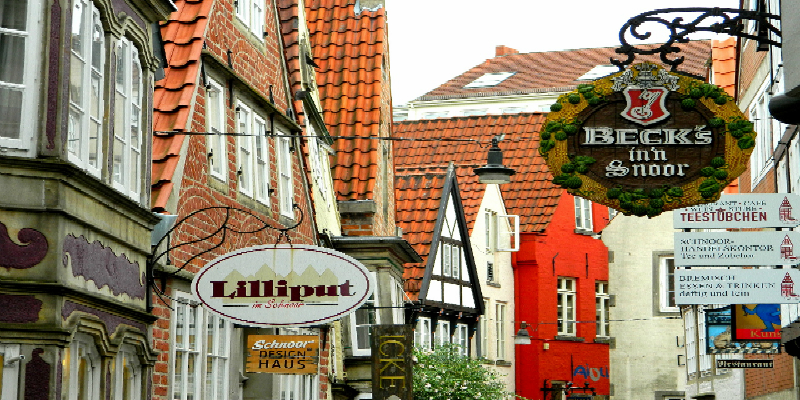We spent a bleak weather day in Hasselt Marina for a final night in Holland. It’s pretty brick canal- side terraced houses boasted modern open plan living and stylish courtyard gardens at which we peered through wide picture windows. In front of each house was an outdoor dining area of tables, chairs and candlesticks, alongside its stretch of the canal.
Entering Germany under dark skies the next morning we stopped at Herzlake, a newish-seeming brick built village where we had our first free night on an aire outside a very swanky local football stadium. The dreary weather meant time to rest up and read novels in the rain.
Bremen is one of the original Hanseatic League towns having protected and privileged trading status in the Middle Ages. It’s glorious Flanders-style market square and Roland Statue, the largest in Germany, still proclaims its importance and great wealth during the 1400s.
Much of the city centre retains its medieval street pattern and we spent a pleasant couple of hours meandering through and around its many alleys and winding lanes which are mostly now shops and small businesses. The ‘schnoor’ quarter is the best example of prettily painted and tumbling-together homes from the 1400s now transformed into lucrative art galleries, cafes, jewellers and gift shops.
We wondered where the city dwellers lived and cycled out to the ‘viertel’ bohemian quarter of 19th century era houses. Row after row of pretty terraced homes painted in soft greys, blues, creams and pinks boasted wrought iron balconies and fully enclosed glass panelled verandas.
Most had trained roses or clematis to grow up along their fronts and around their usually colonnaded porches. It was charming, until you ventured up closer and the reason for the planting became clear.

Graffiti ‘tags’ and slogans were daubed and sprayed on every accessible surface at ground and first floor ground level. Delight was dashed to disappointment, the place seemed horribly grubby.
A youngish chap was spending his Saturday afternoon with a paint brush blocking over ‘tags’ sprayed around his front window. It seemed a modern day challenge for a Sisyphus.

Back on the main street the colourful international shops of clothes, music, books and bric-a-brac were busy and cafes and bars were packed with an eclectic bunch of people of all ages and ethnicity, reminding us of Bremen’s great history as a worldwide trading post.
In the 1930s and again in the 1960s, the city developed its harbour on the River Weser to accommodate manufacturing and industry as well as coffee, spice and fruit importers.
We cycled out to see the impressive development of the Eurohafen as a new residential district for the 21st century. 35million euros of public funding from the EU has been spent in creating working and living accommodation out of the old brick warehouses and a further 1billion euros is being invested by private financiers in soaring riverfront developments of luxury apartments and shopping centres.
Not many residents were yet in situ although parking and public spaces were already well laid out. We found a lunch stop at an authentic docklands pit stop – a café by day and jazz bar by night – and tucked into plates of hot curry wurst, potato salad, sauerkraut and leberkäse (not literally ‘liver cheese’ – it’s a smoked sausage meat loaf served in thick roasted slices).
Cycling (rather heavily) back to town and clocking up 17 miles across our end-to-end tour of the city, it was time to enjoy early evening happy hour beers. We chose to join a crowd that were downstairs in a dark and candlelit beer cellar.
Wilkommen in Deutschland!














